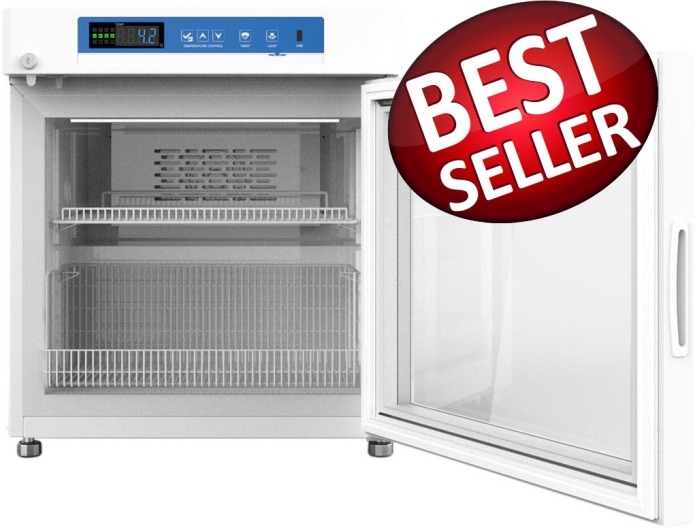The laboratory fridge is a device that cools or freezers samples for storage. It uses a compressor or evaporator to circulate cooled air or water around the samples. The temperature in the fridge can be controlled using a thermostat, and you can control the humidity level by adding a humidifier or dehumidifier.
Lab Refrigerators and Freezers: Features To Look For
There are several features you should keep in mind when looking for a lab refrigerator or freezer. Here are they:
Digital Display
To accurately monitor the temperature, most laboratory refrigerators have a digital display showing the current internal temperature. This is usually located on the exterior of the unit for easy monitoring. You can program the digital display to show the temperature in either Celsius or Fahrenheit. The microprocessor can be programmed to control the temperature within a certain range. The controller can also turn on and off at certain times.
Temperature Control Panel
When it comes to storing perishable items or samples, a reliable refrigerator is a must. Laboratory refrigerators typically operate within a temperature range of 2-10 degrees Celsius, while freezers typically range from -10 to -25 degrees Celsius. Some low-temperature freezers can go as low as -86 degrees Celsius.
Most lab refrigerators and freezers have a digital temperature control panel that allows users to set and monitor the internal temperature. Some units also have an alarm if the temperature falls outside the set range. This is important for preventing samples from being spoiled or damaged.
Door Lock
Some comes with a door lock to prevent accidental or unauthorized opening of the unit. This is an important safety feature, as it helps to prevent samples from being contaminated by outside contaminants.
Audible Alarm
some come with an audible alarm that sounds if the temperature falls outside the set range. This is a valuable safety feature, as it helps to prevent samples from being spoiled or damaged.
Temperature Recording Feature
Some laboratory refrigerators and laboratory freezers have a temperature recording feature that allows users to track the internal temperature over time. This is useful for keeping track of how long certain samples have been stored and detecting any changes in the unit's internal temperature.
Flammable and/or explosion-proof units
There are certain circumstances where a flammable and/or explosion-proof unit may be necessary. These units are designed to prevent fires and explosions in areas where volatile chemicals are present. If you work with flammable or explosive materials, check with your local code authority to see if these units are required.
When choosing a lab refrigerator or freezer, it's important to keep your specific needs in mind. If you need to store flammable or explosive materials, be sure to choose a unit that is designed for this purpose. By following these tips, you can help ensure that your Devices meets all of your needs.
What Are The Key Differences Between Manual And Auto Defrost Lab Refrigerators And Freezers?
Manual and Auto Defrost Lab Refrigerators and Lab Freezers are two different laboratory appliances used to store perishable or non-perishable items. Manual defrost appliances require the user to manually remove the ice buildup on the coils. In contrast, auto defrosts models have a heating element that automatically melts the ice. Manual defrost models are typically less expensive than auto defrost models.
Manual defrost units also tend to be more energy efficient because they do not use the extra energy required to operate the heating element. Ice buildup on coils can decrease the efficiency of manual and auto defrost models if not properly maintained, so it is important to regularly check and clean both appliances.
Optional Accessories For Lab Refrigerator And Freezer
There are a few optional accessories that you might want to consider. These include:
1. A door alarm that sounds when the door is left open for too long. This is helpful if you have forgetful employees or are worried about children entering the fridge.
2. A temperature logger records the temperature inside the device over time. This helps keep track of the temperature in case there's an issue with the fridge or freezer.
3. Drawers and baskets that help keep things organized inside the fridge or freezer. This is helpful if you have a lot of small items that you need to keep track of.
4. Sensor ports to access internal scientific equipment. This is helpful if you need to monitor the temperature or humidity inside the fridge or freezer.
5. Casters or levelers vs. legs. Casters make moving the fridge or freezer easier, while levelers help keep it stable. Casters might be a better option if you're planning on moving the fridge or freezer often.
Internal electrical outlets that provide power to scientific equipment. This is helpful if you need to power something inside
7. Additional shelving to provide more storage space. This is helpful if you have many items that need to be stored in the fridge or freezer.
In conclusion, a laboratory refrigerator/freezer is a great option for storing less temperature-sensitive products. It is more energy-efficient than a regular and can be placed in various locations.
Best types laboratory Lab Refrigerator And Freezer
1.
PHARMACY REFRIGERATOR 2-8 DEG. C 55 LITER
External Size (WDH)mm: 540*560*632
Internal Size(WDH)mm: 444*440*404
Power Consumption (kWh/24h): 0.6
Voltage: 220V/50Hz or customized as 220V,60Hz or 110V,60Hz
Temp.Range(deg.C): 2~8
Alarm: Visual & Audio

2.
PHARMACY REFRIGERATOR 2-8 DEG. C 315 LITER
● Capacity: 315 Liters.
● Temp range 2°C ~ 8°C
● External size : 650x673x1762 - (WDH)mm.
● Internal size : 580x533x1122 - (WDH)mm.
● Upright type.

3.
LABORATORY FREEZER TEMP -TO -25 DEG.C 90 LITERS
Temperature range: -10 to 25- deg.C
LCD display
ABS material interior

4.
FREEZER FOR LABORATORIES -25 DEG C 270 LITER
Temperature range: -10 to 25- deg.C
LCD display
ABS material interior
90 mm extra thick insulation
